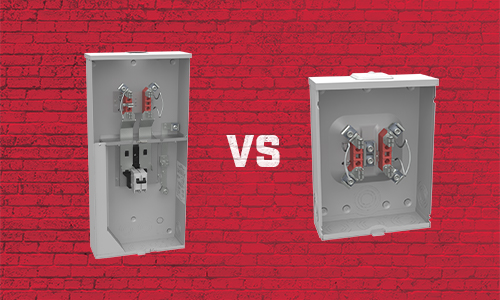Know Your Technical Terms: SCCR and AIC
.jpg)
Milbank meter mains and meter sockets are two products that are given an AIC rating or SCCR. Here's what you should know about each term.
In conversation or in writing, you might have seen references to a Short-Circuit Current Rating (SCCR) and Ampere Interrupting Capacity (AIC) used interchangeably. Both seem to be used in close proximity and are just technical and confusing enough that they are often misidentified or mistaken to mean the same thing. We asked some product experts at Milbank to help explain what SCCR and AIC mean and just how they differ from each other.
Ampere Interrupting Capacity (AIC)
To make it a little more complicated, you may also see AIC referred to as “Available Interrupting Current” or “Ampere Interrupting Rating.” All these terms mean the same thing.
The term AIC applies to protective interrupting devices such as circuit breakers and fuses. When a product has an AIC rating, that means it includes circuit protection. A meter main, for example, can have an AIC rating due to the breaker it houses. Products with an AIC rating will typically range from 5K to 200K AIC.
What does an AIC rating describe? The maximum fault current that the protective device can clear safely without welding closed or causing damage to equipment or personnel. AIC ratings are measured using Amps RMS Symmetrical. For example, a device rated 10K AIC will interrupt current up to 10,000 Amps without shorting to ground or exposing live parts.
Short-Circuit Current Rating (SCCR)
A short-circuit current rating applies to a meter socket or a meter main whether it has a disconnect in it or not. (Learn more about what a disconnect is and the purpose it serves.) The breaker in a meter main has an AIC rating, and that breaker limits its SCCR. When looking at how SCCR is measured, how a disconnect trips does not play into it.
The key word when thinking about how SCCR works is “withstand.” What SCCR describes is the maximum fault current that a product can safely withstand or the maximum available fault current of the feed supply that the product may be safely connected to. For example, if the SCCR of a meter socket is 10K, then that means the socket should be able to withstand a three cycle (1/20 of a second) surge of up to 10,000 Amps running through it without breaking down or causing immediate danger.
Sorting it Out
Some metering products might have both an SCCR on the overall product and a different AIC rating on the protective device, which can add to the confusion. Just remember, the AIC rating applies to the means of disconnect inside the product while SCCR looks at the product as a whole and what it can withstand. If you’re looking at a Milbank meter main, the AIC rating only applies to the breaker inside the meter main while the SCCR applies to the entire meter main. The circuit breaker may have an AIC rating higher than the overall SCCR, but the SCCR cannot be higher than the circuit breaker AIC rating. Both might be rated at 10K, but for AIC that would mean the breaker would interrupt or disconnect the current/amperage when surges and faults occur up to 10K before it could cause damage to the device, and for the SCCR that would mean that unit as a whole can safely withstand a surge of up to 10K Amps running through it.
Metering products that do not have an internal means of disconnect like a breaker or a fuse may have an SCCR but will not have an AIC rating. A good example of this is a Milbank U7040-XL-TG meter socket that has been tested to a 30K peak but has no internal disconnect.
Milbank has thousands of metering products that can fulfill the need for every project. Looking for a meter socket or meter main that’s been rated with a certain SCCR or AIC rating? Try our product search or look at our regional specific catalogs for popular products in your area. You can also reach out to your local manufacturers’ representative for help identifying a utility-approved product that will work for your needs.